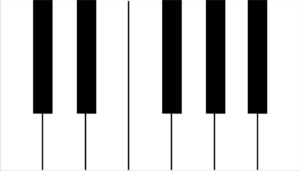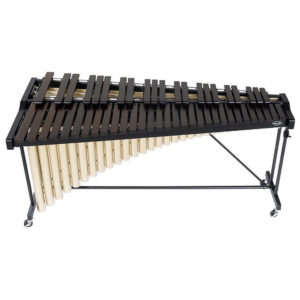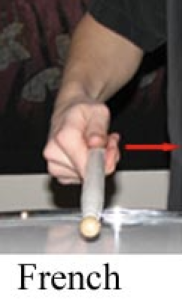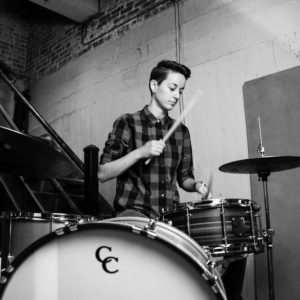There are a few instruments in a percussionists’ arsenal that have multiple pitches. The most common are the keys. The marimba is a pitched instrument with wooden bars. The bars (same with concert bells, xylophones, vibraphones, etc.) are exactly like piano keys. The lower level would be the white keys, and the higher level would be the black keys. Look at the images below to see the similarities.


The pipes below the bars are called “resonators.” They’re what make the different pitches, similar to a pipe organ. The longer the resonator, the deeper the pitch.
When playing the marimba, you should play in the center of the bars. For the upper row, playing on the edge is acceptable. If you ever get to play around with one, you’ll be able to hear the difference in tone when striking various areas of a bar.
Grip!
Your grip should be similar to the timpani’s French grip. Thumbs up, pointing ahead of you, fulcrum between your thumb andforefinger. Play using an upstroke, meaning you’ll begin and end the stroke with the mallet up. Think of it as pulling the sound out of the bar.
Marimba mallets are typically balls of rubber wrapped in yarn. Similar to the different sizes of drumsticks, there are harder or softer mallets, depending on the sound you’re wanting to produce. If you’re a White Stripes fan, you can hear a marimba in “The Nurse.” Here’s a famous marimba soloist, She-e Wu. She’s awesome. (Four mallets!)
~Bianca

All Photos by Bianca Russelburg


I have a little clarification to add for the resonators section. You wrote:
“The pipes below the bars are called “resonators.” They’re what make the different pitches, similar to a pipe organ. The longer the resonator, the deeper the pitch.”
This is kind of true, but also kind of confusing. The purpose of the resonator is to amplify the sound, not determine the pitch.
Essentially, you don’t need resonators to produce a pitch, it just allows for a louder and lusher sound. Note that you can have a long resonator on the highest pitches of the instrument (like many Mussers for example), but this is mostly for decoration. Inside the resonator tube is an end piece (or “stopper”) that corresponds with the pitch of the bar. The stopper should be placed 1/4 the length of the sound wave of its bar in order to resonate best. This allows for a longer, decorative tube in the upper register of the instrument. In most high end marimbas, you have the ability to tune each resonator individually, which is really adjusting the distance between the stopper and the bar itself. When the resonator is in tune with its bar, the sound will be full. An out of tune resonator can make the bar sound dead or it can cause the pitch to shift around the fundamental as the sound decays producing a “wobble.” I hope this provides some additional insight on the physics and mechanics of the instrument.
Also, I found some beef with this line:
“Your grip should be similar to the timpani’s French grip. Thumbs up, pointing ahead of you, fulcrum between your thumb and forefinger.”
Everyone has there own opinion on technique. However, in my many years of marimba study, I’ve never had anyone suggest playing French grip on marimba. A better recommendation may be “American” grip (a compromise of “German” and “French” grips). This allows for better horizontal rotation than German grip would provide, but more control than French grip allows.
Hope this is helpful